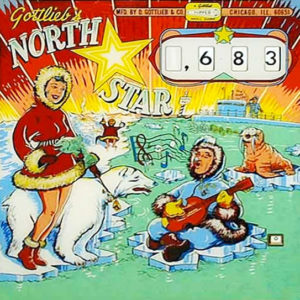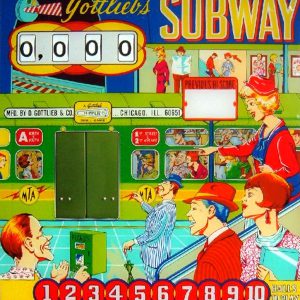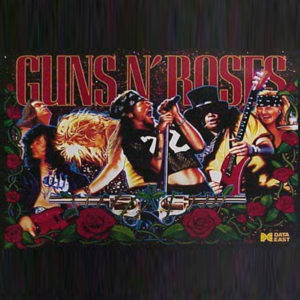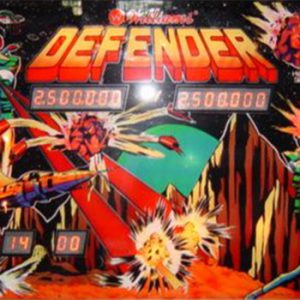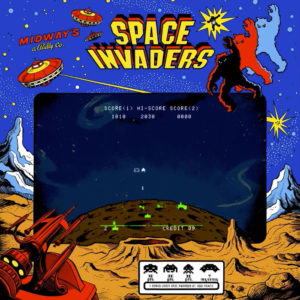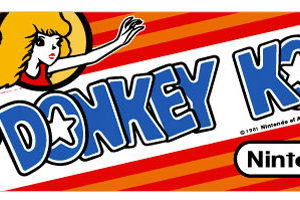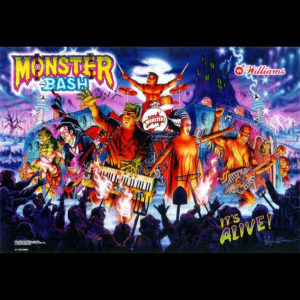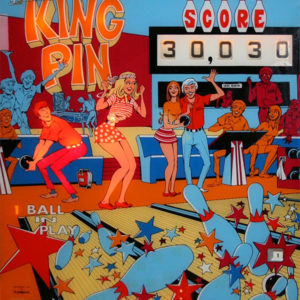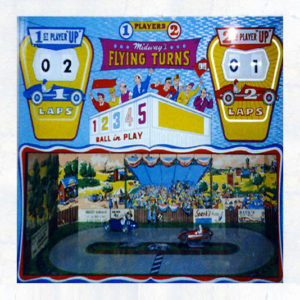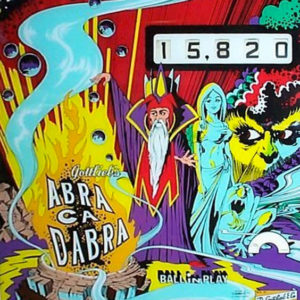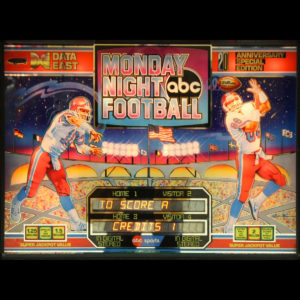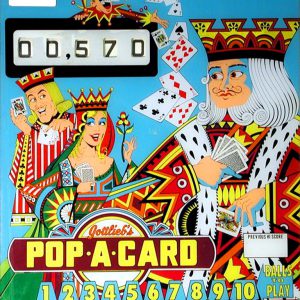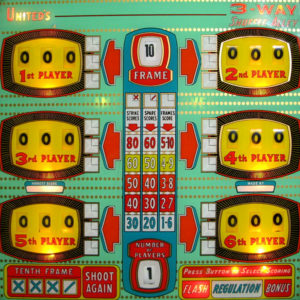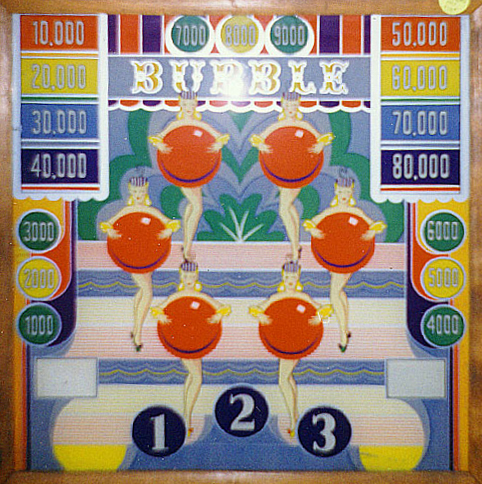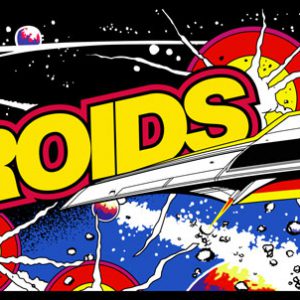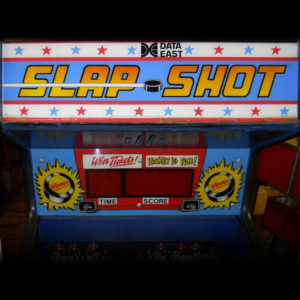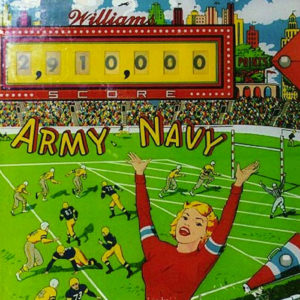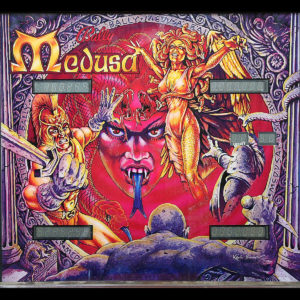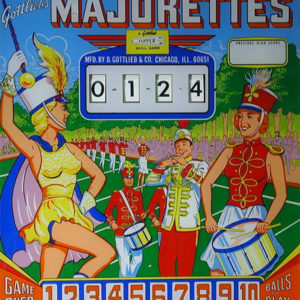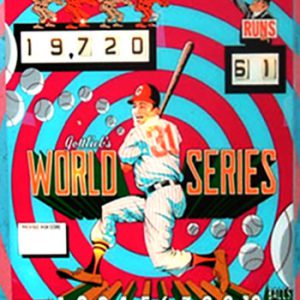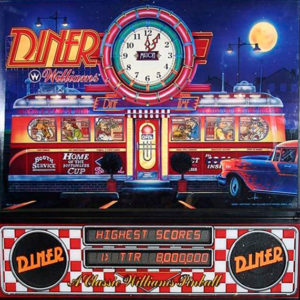-
Gottlieb Subway arrived in October ’66. It was designed by the classic team of Ed Krynski and art by Gordon Morison. This add-a-ball version of the game closely resembled the replay version by the name of Crosstown. This wedgehead Gottlieb has an animated backglass. Every time 100 points are scored, the door of the subway opens, revealing passengers jammed together in a comical pose. The center target is where all the action is in the game. If you happened to match the two columns horizontally by advancing the columns by hitting various spots on the game and hit the center target, the award indicated would be given. Otherwise 10 points were awarded. This game was a tough game to play, as the opening between the flippers was rather large and a hit to the center target would regularly cost you a lost ball.Defender is an arcade video game developed and released by Williams Electronics in 1980. A shooting game featuring two-dimensional (2D) graphics, the game is set on a fictional planet where the player must defeat waves of invading aliens while protecting astronauts. Development was led by Eugene Jarvis, a pinball programmer at Williams; Defender was Jarvis’ first video game project, and drew inspiration from Space Invaders and Asteroids. Defender is a two-dimensional side-scrolling shooting game set on the surface of an unnamed planet. The player controls a space ship as it navigates the terrain, flying either to the left or right. A joystick controls the ship’s elevation, and five buttons control its horizontal direction and weapons. The object is to destroy alien invaders, while protecting astronauts on the landscape from abduction. Humans that are successfully abducted return as mutants that attack the ship. Defeating the aliens allows the player to progress to the next level. Failing to protect the astronauts, however, causes the planet to explode and the level to become populated with mutants. Surviving the waves of mutants results in the restoration of the planet. Players are allotted three chances (lives) to progress through the game and are able to earn more by reaching certain scoring benchmarks. A life is lost if the ship comes into contact with an enemy or its projectiles. After exhausting all lives, the game ends. Defender is an arcade video game developed and released by Williams Electronics in 1980. A shooting game featuring two-dimensional (2D) graphics, the game is set on a fictional planet where the player must defeat waves of invading aliens while protecting astronauts. Development was led by Eugene Jarvis, a pinball programmer at Williams; Defender was Jarvis’ first video game project and drew inspiration from Space Invaders and Asteroids. Defender was one of the most important titles of the Golden Age of Arcade Games, selling over 55,000 units to become the company’s best selling game and one of the highest-grossing arcade games ever. Praise among critics focused on the game’s audio-visuals and gameplay. It is frequently listed as one of Jarvis’ best contributions to the video game industry as well as one of the most difficult video games. Defender was ported to numerous platforms, inspired the development of other games, and was followed by sequels and many imitations. Defender is a two-dimensional side-scrolling shooting game set on the surface of an unnamed planet. The player controls a space ship as it navigates the terrain, flying either to the left or right. A joystick controls the ship’s elevation, and five buttons control its horizontal direction and weapons. The object is to destroy alien invaders while protecting astronauts on the landscape from abduction. Humans who are successfully abducted return as mutants that attack the ship. Defeating the aliens allows the player to progress to the next level. Failing to protect the astronauts, however, causes the planet to explode and the level to become populated with mutants. Surviving the waves of mutants results in the restoration of the planet. Players are allotted three chances (lives) to progress through the game and are able to earn more by reaching certain scoring benchmarks. A life is lost if the ship comes into contact with an enemy or its projectiles. After exhausting all lives, the game end.Donkey Kong is an arcade game released by Nintendo in 1981. It is an early example of the platform game genre, as the gameplay focuses on maneuvering the main character across a series of platforms while dodging and jumping over obstacles. In the game, Jumpman (since renamed Mario) must rescue a damsel in distress, Lady (now named Pauline), from a giant ape named Donkey Kong. The hero and ape later became two of Nintendo’s most popular characters. Donkey Kong is one of the earliest examples of the platform game genre; it is sometimes said to be the first platform game, although it was preceded by Space Panic. In contrast to Space Panic, however, Donkey Kong was the first platform game to feature jumping, introducing the need to jump between gaps and over obstacles or approaching enemies, setting the template for the platform genre. Competitive video gamers and referees stress the game’s high level of difficulty compared to other classic arcade games. Winning the game requires patience and the ability to accurately time Jumpman’s ascent. In addition to presenting the goal of saving the Lady, the game also gives the player a score. Points are awarded for finishing screens; leaping over obstacles; destroying objects with a hammer power-up; collecting items such as hats, parasols, and purses (apparently belonging to the Lady/Pauline); and completing other tasks. The player typically receives three lives with a bonus awarded for the first 7,000 points, although this can be modified via the game’s built in DIP switches. The game is divided into four different one-screen stages. Each represents 25 meters of the structure Donkey Kong has climbed, one stage being 25 meters higher than the previous. The final screen occurs at 100 m. Later ports of the game omit or change the sequence of the screens. The original arcade version includes: Screen 1 (25 m), Jumpman must scale a seven-story construction site made of crooked girders and ladders while jumping over or hammering barrels and oil barrels tossed by Donkey Kong. The hero must also avoid fireballs which generate when barrels run into the oil drum at the bottom of the site. Players routinely call this screen “Barrels”. Screen 2 (50 m), Jumpman must climb a five-story structure of conveyor belts, each of which transports cement pans. The fireballs also make another appearance. This screen is sometimes referred to as the “Factory” or “Pie Factory” due to the resemblance of the cement pans to pies. Screen 3 (75 m), Jumpman rides up and down elevators while avoiding fireballs and bouncing objects, presumably spring weights. The bouncing weights (the hero’s greatest danger in this screen) emerge on the top level and drop near the rightmost elevator. The screen’s common name is “Elevators”. This screen appears as an unlockable stage in Super Smash Bros. Brawl. Screen 4 (100 m), Jumpman must remove the eight rivets which support Donkey Kong. The fireballs remain the primary obstacle. Removing the final rivet causes Donkey Kong to fall and the hero to be reunited with Lady/Pauline. This is the final screen of each level. Players refer to this screen as “Rivets”. The player loses a life if: Jumpman collides with a barrel, fireball, flaming oil barrel, spring weight, cement pan, or Donkey Kong himself Jumpman falls off the structure or through open rivet holes The bonus timer reaches 0. These screens combine to form levels, which become progressively tougher. For example, Donkey Kong begins to hurl barrels faster and sometimes diagonally, and fireballs get speedier. The victory music alternates between levels 1 and 2. The 22nd level is unofficially known as the kill screen, due to an error in the game’s programming that kills Mario after a few seconds, effectively ending the game. With its four unique levels, Donkey Kong was the most complex arcade game at the time of its release, and only the second game to feature multiple levels (the first was Gorf by Midway Games).This is it. The ultimate collectible game of the ‘70s according to the literature. Bally put together Ted Zale and Dave “Mad Dog” Christianson to design the game. Production run was 3,815 units. Many firsts here. The whirlwind spinning disk was a first to throw off the ball once rolled upon. A messenger ball (captive ball) was a variation on a theme. The art package is truly amazing. A lower-left kick-back kicker, when activated, returns your ball to play. A free ball gate returns your ball to the plunger. “Zipperflippers”, a first, closes the gap between the flippers, when activated, preventing the loss of the ball thru the center drain until turned off. Once you lock two balls in the “odin” and “wotan” kickout holes, then hit “release messenger balls”, three balls are in play. No jackpot in multiball in this game was developed. You just had a period of high scoring and pinball chaos to contend with until you lost the first two balls in play.This very collectible game of the ‘70s was another in a series of celebrity-themed tie-in games Bally found license to produce. 17,000 units were made, a sizable number for the day. A prototype speaking version of this game was made ahead of its time but failed to be marketed. The object of the game is to spell out the name KISS. If you complete four times, a super bonus is awarded. Do it again and a colossal bonus is awarded. A third time awards a replay and a ton of points…which can be doubled if the 2x value drop targets are completed. The A, B, C, and D targets also can award extra balls and specials. The left drop targets award the KISS line when completed. All in all, an exciting game with great graphics but no speech. Talking pinballs finally made the scene with the release of Gorgar (in the museum). Replays are also awarded by score or matching. Matching is the process by which the last two numbers of your score match the generated number produced by the game.Frogger is an arcade game introduced in 1981. It was developed by Konami, and licensed for worldwide distribution by Sega/Gremlin. The object of the game is to direct frogs to their homes one by one. To do this, each frog must avoid cars while crossing a busy road and navigate a river full of hazards. Skillful players may obtain some bonuses along the way. The game is regarded as a classic from the golden age of video arcade games and was noted for its novel gameplay and theme. It was also an early example of a game using more than one CPU, as it used two Z80 processors. Frogger is still popular and versions can be found on many Internet game sites. By 2005, Frogger had sold 20 million copies worldwide, including 5 million in the United States. The player starts with three, five, or seven frogs (lives). The player guides a frog which starts at the bottom of the screen. The lower half of the screen contains a road with motor vehicles, which in various versions include cars, trucks, buses, dune buggies, bulldozers, vans, taxis, bicyclists, and/or motorcycles, speeding along it horizontally. The upper half of the screen consists of a river with logs, crocodiles, and turtles, all moving horizontally across the screen. The very top of the screen contains five “frog homes” which are the destinations for each frog. Every level is timed; the player must act quickly to finish each level before the time expires. The only player control is the joystick used to navigate the frog; each push in a direction causes the frog to hop once in that direction. On the bottom half of the screen, the player must successfully guide the frog between opposing lanes of trucks, cars, and other vehicles, to avoid becoming roadkill. The middle of the screen, after the road, contains a median where the player must prepare to navigate the river. By jumping on swiftly moving logs and the backs of turtles, the player can guide his or her frog safely to one of the empty lilypads. The player must avoid crocodiles, snakes, and otters in the river, but may catch bugs or escort a lady frog for bonuses. When all five frogs are directed home, the game progresses to the next, harder level. After five levels, the game gets briefly easier yet again gets progressively harder to the next fifth level. There are many different ways to lose a life in this game (illustrated by a “skull and crossbones” symbol where the frog was), including: 1.Being hit by a road vehicle 2.Jumping into the river’s water 3.Running into snakes, otters or into a crocodile’s jaws in the river 4.Jumping into a home invaded by a crocodile 5.Staying on top of a diving turtle until it has completely submerged 6.Riding a log, crocodile, or turtle off the side of the screen 7.Jumping into a home already occupied by a frog 8.Jumping into the side of a home or the bush 9.Running out of time before getting a frog home Frogger is available as a standard upright or cocktail cabinet. The controls consist solely of a 4-direction joystick used to guide the frog’s jump direction. The number of simultaneous players is one, and the game has a maximum of two players. The game’s opening tune is the first verse of a Japanese children’s song called Inu No Omawarisan (The Dog Policeman). The song remained intact in the US release. Other Japanese tunes that are played during gameplay include the themes to the anime Hana no Ko Lunlun and Araiguma Rascal.Gottlieb Pop-A-Card was another classic ‘70s playfield designed by Ed Krynski with artwork by Gordon Morison. Only 825 of these units were made. The replay version of the game was called Drop–A-Card which, as usual, was a much higher produced machine. The open playfield of this game gives ample room for scoring the three banks of drop targets. To win free balls with this game, you have to either complete the 2, 3, 4, and 5 targets, or the 6, 7, 8, and 9 targets…or the 10, J, Q, K, and Ace targets. The first two options light the wow feature to award free balls during that ball in play. If you hit the 10 thru Ace targets to completion, four rollovers light up to score extra balls. Of course, score is another way to score more balls.Yet another legendary, genre-defining game – in an era replete with genre-defining classics - in which a single player takes control of a ship trapped in the middle of an asteroid field. A number of large, slow-moving asteroids drift randomly around the play area and must be shot by the player. When shot, the asteroids will break into a number of smaller pieces, which must also be shot until, eventually, all of the asteroids and fragments will be destroyed and the next wave begins. Asteroids introduced real-world physics to video games for the first time, with speed and inertia all adding to the player’s problems. As well as the inertia of the player’s ship – forcing the player to allow for the ship slowing down and speeding up whenever the thrust button was utilized – shot asteroids would often send fragments flying in seemingly random directions, and at varying and unpredictable speeds. As well as the ever-present asteroids, alien saucers also make a regular appearance. These move diagonally around the screen, firing at the player’s ship and must be quickly destroyed.In this, the first proper sequel to Namco’s legendary pill-eating maze game, players must once again run around a number of mazes, eating all of the pills that are scattered throughout. The ever-present ghosts (Blinky, Pinky, Inky and Sue) return to hamper the player’s progress. The infamous “power pills” are also present and correct, with four appearing in each maze. Namco introduced a number of changes and enhancements over the original game. The first difference is in the main character. For the first time in video-game history, the game’s lead character was female. Ms. Pac-man is almost identical to the original character with two main differences: she wears a bow in her “hair” and is also wearing lipstick. Another change from the original is that the bonus fruit items are no longer static but now move randomly around the mazes. Ms. Pac-man features four different maze layouts, which alternate every two to four screens: the first maze is only encountered in rounds 1 and 2 and has 220 dots and four power pills. There are two sets of tunnels in this maze equidistant from the center of the maze. You must clear this maze twice before moving on to the next maze. The second maze is only encountered in rounds 3, 4, and 5, and has 240 dots and four power pills. There are two sets of tunnels in this maze: one set in the lower half, and the other set at the very top. You must clear this maze three times before moving on to the next maze. The third maze is first encountered in round 6 and has 238 dots and four power pills. Unlike all other mazes, there is only one set of tunnels in this maze, slightly above the center of the board. You must clear this maze four times before moving on to the next maze. The fourth and final unique maze is first encountered in round 10 and has 234 dots and four power pills. There are two sets of tunnels in this maze, directly next to one another in the middle of the maze. The turns at the entrance to the tunnels change the usual immediate accessibility of the tunnels and should be taken into account. You must clear this maze four times before moving on to the next maze.Gottlieb produced a few baseball-themed games, but Williams Manufacturing was the king of these types of games. This game, designed by Ed Krynski with art by Gordon Morison, had a run of 775 units. This is the add-a-ball version of this game, so it is rarer. The replay version is called Grand Slam. This game has eject holes which activate the roto-target, a Gottlieb exclusive device, which stops and a man is lit on a corresponding base to the eject hole on the baseball diamond. The rollover button lights when the bases are loaded. This scores 1,000 points whenever the bases are loaded. Runs and score are the ways to win free balls with this game.
HOURS: MON–THU: 12PM–12AM • FRI-SAT: 11AM-2AM • SUN: 11AM-12AM | 19 NE 3RD AVE., DELRAY BEACH, FL | (561) 266-3294 | Email Club



